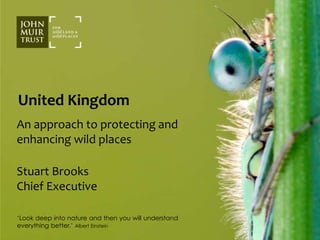The approach to protecting and enhancing wild places
- 1. United Kingdom An approach to protecting and enhancing wild places Stuart Brooks Chief Executive ŌĆśLook deep into nature and then you will understand everything better.ŌĆÖ Albert Einstein
- 3. ŌĆó To Protect ŌĆó To Enhance ŌĆó To Engage
- 4. Pristine Wilderness Managed Wild Land Wildness Urban Greenspace Ecosystem Health A quality experienced by people Wildlife Wild Places People Rewilding
- 7. Stronelairg Stronelairg: from Geal Charn (Monadhliath)
- 10. ŌĆ£Most people are on the world, not in it, have no sympathy or relationship to anything about them - undiffused, separate, and rigidly alone like marbles of polished stone, touching but separate.ŌĆØ John Muir
- 11. ŌĆ£Our experiences shape our values. When we engage values repeatedly, they become entrenched and we regard them as important.ŌĆØ Common Cause for Nature ŌĆ£Fresh air comes into your body and all the bad stuff goes outŌĆØ
Editor's Notes
- #3: We take our name and inspiration from John Muir ŌĆō celebrated this year in Scotland and US ŌĆō 100 years since his passing.
- #4: What IŌĆÖd like to do is to give you a brief update on progress in the UK. It is framed around the 3 elements that I think are necessary and have to work together to secure a positive future for wilderness and wild places. ThatŌĆÖs to create effective legislation to protect the resource, to enhance its qualities and to engage people in its values. Who is the John Muir Trust?
- #5: This graphic attempts to explain the relationship between these issues ŌĆō across the centre depicts relative wildness ŌĆō from pristine wilderness to urban greenspace (continue on to urban). These classifications encompass a range of attributes ŌĆō familiar to us; naturalness and remoteness are best true measures.
- #6: You can do that in principle ŌĆō but to be effective as a tool within planning development ŌĆō it requires a spatial approach ŌĆō lines on maps. This is not a true reflection of the spectrum of wildness, but its what works. After 30 years ŌĆō the Trust has helped to establish recognition of wild land as a ŌĆśnational assetŌĆÖ. Three key elements to this happening; Public pressure on politicians to stop development in these areas ŌĆō press campaigns important Technical solution to the problem ŌĆō scientific credibility Political willingness ŌĆō to see the down sides of uncontrolled development in terms of votes
- #7: But, still huge pressures at play, money and politics
- #9: Now dealing with new planning legislation ŌĆō so we can use new tools. So far, all decisions have gone our way ŌĆō a real turnaround of fortunes.
- #10: The map is largely seen as a map of constraint ŌĆō we want it to be seen as a map of opportunity ŌĆō to improve what we already have. The rewilding movement is now gathering considerable pace in the UK. This is direct result of Vision for a Wilder Europe, Feral and very active debate in UK in the last 18 months. Established NGOs are considering whether to resist, embrace or watch from the sidelines.
- #11: There appears to be a general consensus that somehow society is disconnected from nature ŌĆō we no longer understand it, value it ŌĆō and therefore the job of protecting and enhancing ŌĆō as opposed to developing it is much harder. This is not a new phenomenon. However, many people are sympathetic to our general aims, they can appreciate beautiful landscapes and wildlife (perhaps more often these days from the car window or couch) ŌĆō so how do we encourage those people to take that next step where they learn to value through real life experiences.
- #12: This is the third element ŌĆō and possibly the most important. It requires us to remove barriers to access and create opportunities for experience. Only with experience will we truly value.
- #13: This all requires funding ŌĆō we have to be sophisticated and invest in communications and marketing ŌĆō people respond best to the emotional rather than the intellectual arguments. I think we are going in the right direction ŌĆō even though our wild places are coming under more pressure, there is more public and political awareness ŌĆō values and benefits are key to enabling change.













